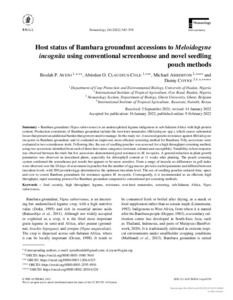| dc.contributor.author | Ayeni, B.P. |
| dc.contributor.author | Claudius-Cole, A.O. |
| dc.contributor.author | Abberton, M. |
| dc.contributor.author | Coyne, D. |
| dc.date.accessioned | 2022-07-13T08:46:28Z |
| dc.date.available | 2022-07-13T08:46:28Z |
| dc.date.issued | 2022-02-09 |
| dc.identifier.citation | Ayeni, B.P., Claudius-Cole, A.O., Abberton, M. & Coyne, D. (2022). Host status of Bambara groundnut accessions to Meloidogyne incognita using conventional screenhouse and novel seedling pouch methods. Nematology, 24, 543-558. |
| dc.identifier.issn | 1388-5545 |
| dc.identifier.uri | https://hdl.handle.net/20.500.12478/7540 |
| dc.description.abstract | Bambara groundnut (Vigna subterranea) is an underexploited legume indigenous to sub-Saharan Africa with high protein content. Production constraints of Bambara groundnut include the root-knot nematodes (Meloidogyne spp.), which causes substantial losses that present an additional burden that growers need to manage. In this study we: i) assessed genetic resistance against Meloidogyne incognita in Bambara groundnut; and ii) evaluated an improved, more efficient screening method for Bambara. Fifty accessions were evaluated in two screenhouse trials. Following this, the use of seedling pouches was assessed for a high throughput screening method, using two accessions identified from each of three host status categories (resistant, tolerant and susceptible). Variability in host response was observed between the trials but five accessions demonstrated good resistance to M. incognita. A general reduction in plant growth parameters was observed on inoculated plants, especially for chlorophyll content at 11 weeks after planting. The pouch screening system confirmed the screenhouse pot results but appears to be more sensitive. From a range of inocula no differences in gall index were observed over the 28 days of assessment in pouches but the number of egg masses proved a useful parameter and differed between inoculum levels, with 500 juveniles/eggs determined as the optimum inoculum level. The use of seedling pouches reduced time, space and cost to screen Bambara groundnuts for resistance against M. incognita. Consequently, it is recommended as an efficient, high throughput, rapid screening protocol for Bambara groundnut compared to conventional pot screening methods. |
| dc.format.extent | 543-558 |
| dc.language.iso | en |
| dc.subject | Food Security |
| dc.subject | Legumes |
| dc.subject | Screening |
| dc.subject | Africa South of Sahara |
| dc.subject | Meloidogyne Incognita |
| dc.subject | Vigna Subterranea |
| dc.title | Host status of Bambara groundnut accessions to Meloidogyne incognita using conventional screenhouse and novel seedling pouch methods |
| dc.type | Journal Article |
| cg.contributor.crp | Grain Legumes |
| cg.contributor.affiliation | University of Ibadan |
| cg.contributor.affiliation | International Institute of Tropical Agriculture |
| cg.coverage.region | Africa |
| cg.coverage.region | West Africa |
| cg.coverage.country | Nigeria |
| cg.coverage.hub | Eastern Africa Hub |
| cg.coverage.hub | Headquarters and Western Africa Hub |
| cg.researchtheme | Biotech and Plant Breeding |
| cg.researchtheme | Natural Resource Management |
| cg.identifier.bibtexciteid | AYENI:2022 |
| cg.isijournal | ISI Journal |
| cg.authorship.types | CGIAR and developing country institute |
| cg.iitasubject | Aflatoxin |
| cg.iitasubject | Agronomy |
| cg.iitasubject | Food Security |
| cg.iitasubject | Grain Legumes |
| cg.iitasubject | Natural Resource Management |
| cg.iitasubject | Plant Breeding |
| cg.journal | Nematology |
| cg.notes | Open Access Article |
| cg.accessibilitystatus | Open Access |
| cg.reviewstatus | Peer Review |
| cg.usagerightslicense | Creative Commons Attribution-NonCommercial 4.0 (CC BY-NC 4.0) |
| cg.targetaudience | Scientists |
| cg.identifier.doi | https://dx.doi.org/10.1163/15685411-bja10150 |
| cg.iitaauthor.identifier | Michael Abberton: 0000-0003-2555-9591 |
| cg.iitaauthor.identifier | Daniel Coyne: 0000-0002-2030-6328 |
| cg.futureupdate.required | No |
| cg.identifier.issue | 5 |
| cg.identifier.volume | 24 |

